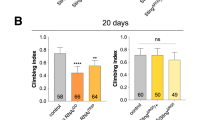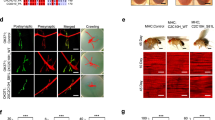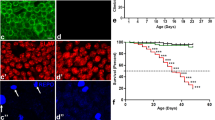Abstract
Parkinson's disease is the second most common neurodegenerative disorder and is characterized by the degeneration of dopaminergic neurons in the substantia nigra. Mitochondrial dysfunction has been implicated as an important trigger for Parkinson's disease-like pathogenesis because exposure to environmental mitochondrial toxins leads to Parkinson's disease-like pathology1. Recently, multiple genes mediating familial forms of Parkinson's disease have been identified, including PTEN-induced kinase 1 (PINK1 ; PARK6 ) and parkin (PARK2 ), which are also associated with sporadic forms of Parkinson's disease2,3,4,5,6. PINK1 encodes a putative serine/threonine kinase with a mitochondrial targeting sequence2. So far, no in vivo studies have been reported for pink1 in any model system. Here we show that removal of Drosophila PINK1 homologue (CG4523; hereafter called pink1) function results in male sterility, apoptotic muscle degeneration, defects in mitochondrial morphology and increased sensitivity to multiple stresses including oxidative stress. Pink1 localizes to mitochondria, and mitochondrial cristae are fragmented in pink1 mutants. Expression of human PINK1 in the Drosophila testes restores male fertility and normal mitochondrial morphology in a portion of pink1 mutants, demonstrating functional conservation between human and Drosophila Pink1. Loss of Drosophila parkin shows phenotypes similar to loss of pink1 function7,8. Notably, overexpression of parkin rescues the male sterility and mitochondrial morphology defects of pink1 mutants, whereas double mutants removing both pink1 and parkin function show muscle phenotypes identical to those observed in either mutant alone. These observations suggest that pink1 and parkin function, at least in part, in the same pathway, with pink1 functioning upstream of parkin. The role of the pink1–parkin pathway in regulating mitochondrial function underscores the importance of mitochondrial dysfunction as a central mechanism of Parkinson's disease pathogenesis.
This is a preview of subscription content, access via your institution
Access options
Subscribe to this journal
Receive 51 print issues and online access
$199.00 per year
only $3.90 per issue
Buy this article
- Purchase on Springer Link
- Instant access to full article PDF
Prices may be subject to local taxes which are calculated during checkout




Similar content being viewed by others
References
Moore, D. J., West, A. B., Dawson, V. L. & Dawson, T. M. Molecular pathophysiology of Parkinson's disease. Annu. Rev. Neurosci. 28, 57–87 (2005)
Valente, E. M. et al. Hereditary early-onset Parkinson's disease caused by mutations in PINK1. Science 304, 1158–1160 (2004)
Kitada, T. et al. Mutations in the parkin gene cause autosomal recessive juvenile parkinsonism. Nature 392, 605–608 (1998)
Bonifati, V. et al. Early-onset parkinsonism associated with PINK1 mutations: frequency, genotypes, and phenotypes. Neurology 65, 87–95 (2005)
Klein, C. et al. PINK1, Parkin, and DJ-1 mutations in Italian patients with early-onset parkinsonism. Eur. J. Hum. Genet. 13, 1086–1093 (2005)
Ibanez, P. et al. Mutational analysis of the PINK1 gene in early-onset parkinsonism in Europe and North Africa. Brain 129, 686–694 (2006)
Greene, J. C. et al. Mitochondrial pathology and apoptotic muscle degeneration in Drosophila parkin mutants. Proc. Natl Acad. Sci. USA 100, 4078–4083 (2003)
Pesah, Y. et al. Drosophila parkin mutants have decreased mass and cell size and increased sensitivity to oxygen radical stress. Development 131, 2183–2194 (2004)
Fuller, M. T. in The Development ofDrosophila melanogaster 71–147 (Cold Spring Harbor Laboratory Press, Cold Spring Harbor, New York, 1993)
Van Steeg, H., Oudshoorn, P., Van Hell, B., Polman, J. E. & Grivell, L. A. Targeting efficiency of a mitochondrial pre-sequence is dependent on the passenger protein. EMBO J. 5, 3643–3650 (1986)
Silvestri, L. et al. Mitochondrial import and enzymatic activity of PINK1 mutants associated to recessive parkinsonism. Hum. Mol. Genet. 14, 3477–3492 (2005)
Meulener, M. et al. Drosophila DJ-1 mutants are selectively sensitive to environmental toxins associated with Parkinson's disease. Curr. Biol. 15, 1572–1577 (2005)
Menzies, F. M., Yenisetti, S. C. & Min, K. T. Roles of Drosophila DJ-1 in survival of dopaminergic neurons and oxidative stress. Curr. Biol. 15, 1578–1582 (2005)
Yang, Y. et al. Inactivation of Drosophila DJ-1 leads to impairments of oxidative stress response and phosphatidylinositol 3-kinase/Akt signaling. Proc. Natl Acad. Sci. USA 102, 13670–13675 (2005)
Park, J. et al. Drosophila DJ-1 mutants show oxidative stress-sensitive locomotive dysfunction. Gene 361, 133–139 (2005)
Bonifati, V. et al. Mutations in the DJ-1 gene associated with autosomal recessive early-onset Parkinsonism. Science 299, 256–259 (2003)
Przedborski, S. & Ischiropoulos, H. Reactive oxygen and nitrogen species: weapons of neuronal destruction in models of Parkinson's disease. Antioxid. Redox Signal. 7, 685–693 (2005)
Huh, J. R. et al. Multiple apoptotic caspase cascades are required in nonapoptotic roles for Drosophila spermatid individualization. PLoS Biol. 2, E15 (2004)
Brand, A. H. & Perrimon, N. Targeted gene expression as a means of altering cell fates and generating dominant phenotypes. Development 118, 401–415 (1993)
Whitworth, A. J. et al. Increased glutathione S-transferase activity rescues dopaminergic neuron loss in a Drosophila model of Parkinson's disease. Proc. Natl Acad. Sci. USA 102, 8024–8029 (2005)
Fleming, S. M., Fernagut, P. O. & Chesselet, M. F. Genetic mouse models of parkinsonism: strengths and limitations. NeuroRx 2, 495–503 (2005)
Palacino, J. J. et al. Mitochondrial dysfunction and oxidative damage in parkin-deficient mice. J. Biol. Chem. 279, 18614–18622 (2004)
Braak, H. et al. Staging of brain pathology related to sporadic Parkinson's disease. Neurobiol. Aging 24, 197–211 (2003)
Ahlqvist, G., Landin, S. & Wroblewski, R. Ultrastructure of skeletal muscle in patients with Parkinson's disease and upper motor lesions. Lab. Invest. 32, 673–679 (1975)
Bindoff, L. A., Birch-Machin, M. A., Cartlidge, N. E., Parker, W. D. Jr & Turnbull, D. M. Respiratory chain abnormalities in skeletal muscle from patients with Parkinson's disease. J. Neurol. Sci. 104, 203–208 (1991)
Wiedemann, F. R., Winkler, K., Lins, H., Wallesch, C. W. & Kunz, W. S. Detection of respiratory chain defects in cultivated skin fibroblasts and skeletal muscle of patients with Parkinson's disease. Ann. NY Acad. Sci. 893, 426–429 (1999)
Hay, B. A., Wolff, T. & Rubin, G. M. Expression of baculovirus P35 prevents cell death in Drosophila. Development 120, 2121–2129 (1994)
Tokuyasu, K. T., Peacock, W. J. & Hardy, R. W. Dynamics of spermiogenesis in Drosophila melanogaster. I. Individualization process. Z. Zellforsch. Mikrosk. Anat. 124, 479–506 (1972)
Benzer, S. Genetic dissection of behaviour. Sci. Am. 229, 24–37 (1973)
Hanks, S. K. & Hunter, T. Protein kinases 6. The eukaryotic protein kinase superfamily: kinase (catalytic) domain structure and classification. FASEB J. 9, 576–596 (1995)
Acknowledgements
We thank G. Mardon and L. Pallanck for parkin cDNA and mutant flies; A. Simon, D. Walker, X. Zhan and A. Kiger for technical advice; L. Zipursky, L. Toro and D. Krantz for access to equipment and space; Guo laboratory members for discussions; and the EM core facilities at UCLA Brain Research Institute and at Caltech. We are indebted to R. Young in Seymour Benzer's laboratory for assistance with EM, and F. Laski for his phase contrast microscope. This work was supported by a National Institute of Health (NIH) grant to B.A.H. and an Alfred P. Sloan Foundation Fellowship in Neuroscience and a NIH grant to M.G. Author Contributions I.E.C., M.W.D., C.J. and J.H.C. in the Guo laboratory conceived and performed the experiments. J.R.H. and B.A.H. in the Hay laboratory assisted with experiments involving TEM in testes and with TUNEL staining; J.H.S. and S.J.Y. provided crucial reagents; and M.G. conceived and performed experiments, supervised the work, and wrote the manuscript with helpful comments from B.A.H. and authors from the Guo laboratory.
Author information
Authors and Affiliations
Corresponding author
Ethics declarations
Competing interests
Reprints and permissions information is available at npg.nature.com/reprintsandpermissions. The authors declare no competing financial interests.
Supplementary information
Supplementary Figure 1
Sequence alignment and expression pattern of pink1. (JPG 517 kb)
Supplementary Figure 2
Loss of pink1 function does not cause changes in the number of dopaminergic neurons in the brain. (JPG 255 kb)
Supplementary Figure 3
pink1 flies have profound defects in flight behaviour. (JPG 169 kb)
Supplementary Notes
This file contains Supplementary Figure Legends and Supplementary Materials. (DOC 39 kb)
Rights and permissions
About this article
Cite this article
Clark, I., Dodson, M., Jiang, C. et al. Drosophila pink1 is required for mitochondrial function and interacts genetically with parkin. Nature 441, 1162–1166 (2006). https://doi.org/10.1038/nature04779
Received:
Accepted:
Published:
Issue Date:
DOI: https://doi.org/10.1038/nature04779
This article is cited by
-
ErZhiTianGui Decoction alleviates age-related ovarian aging by regulating mitochondrial homeostasis and inhibiting ferroptosis
Journal of Ovarian Research (2024)
-
Mitochondrial CISD1/Cisd accumulation blocks mitophagy and genetic or pharmacological inhibition rescues neurodegenerative phenotypes in Pink1/parkin models
Molecular Neurodegeneration (2024)
-
Activation of Ca2+ phosphatase Calcineurin regulates Parkin translocation to mitochondria and mitophagy in flies
Cell Death & Differentiation (2024)
-
Elevated Level of PINK1/Parkin-Mediated Mitophagy Pathway Involved to the Inhibited Activity of Mitochondrial Superoxide Dismutase in Rat Brains and Primary Hippocampal Neurons Exposed to High Level of Fluoride
Biological Trace Element Research (2024)
-
Autophagy: a necessary evil in cancer and inflammation
3 Biotech (2024)
Comments
By submitting a comment you agree to abide by our Terms and Community Guidelines. If you find something abusive or that does not comply with our terms or guidelines please flag it as inappropriate.



